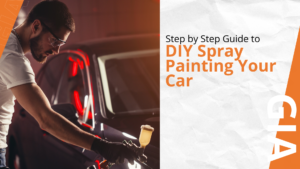Spray painting your vehicle can be a rewarding project, allowing you to customize or restore your car’s appearance. While it might seem daunting at first, with the right tools, techniques, and patience, you can achieve a professional-looking finish. Here’s a step-by-step guide to help you get started.
Why Spray Paint Your Car?
Enhanced aesthetic appeal – a new coat of paint offers an exciting appearance to the car, filling it with lacquer and vibrancy. Whether revitalising or personalising a new one, this new paint will make your car truly stand out.
Protection versus rust and corrosion – properly applied paint protects the surface of the car from elements that may cause rusting. Especially in harsh weather where moisture can quickly result in damage.
Increased resale value – a well-maintained exterior may considerably help increase your car’s value by attracting more buyers. A new coat of paint gives the car a fresher look, giving the impression that it’s well-handled.
Necessary Tools and Materials for Your Car Spray Painting
- Spray Gun: A quality HVLP (High Volume Low Pressure) spray gun is essential for even paint application. For beginners, a gravity-fed spray gun is easier to control.
- Air Compressor: Ensure your air compressor matches the spray gun’s requirements in terms of pressure and volume.
- Paint: Choose automotive-grade paint. Depending on your project, you may need a base coat, clear coat, and possibly a primer.
- Sanding Tools: Sandpaper (ranging from 320 to 2000 grit), a sanding block, and a dual-action sander.
- Masking Tape and Paper: Use automotive masking tape and paper to cover areas you don’t want to paint, like windows, trim, and lights.
Step-by-Step Guide to DIY Spray Painting Your Car

1. Sanding
Sanding the car will remove the old paint and give it a smooth surface for the new paint coat. You can use an abrasive material, such as 320- to 600-grit sandpaper since proper adhesion requires this step. Sanding also helps in removing surface imperfections, including scratches and chips.
2. Cleaning and area prepping
Properly clean the car to remove dust, grease, or other dirt. You can clean with a solvent such as wax or grease remover to ensure the surface is clean.
Any type of residue will affect the outcome of your paint job so ensure that ventilation is provided in your work area. It should also be free from any dust that might fall onto the wet paint.
3. Masking
Use masking tape and paper to mask off areas you will not paint, such as windows, tires, and trim. The quality of your masking job will determine how crisp your finished lines are. So take time to ensure the edges are tight and the coverage is good.
4. Priming
Apply a primer over the car’s surface. It provides good paint adhesion to the metal and creates a level and uniform base for the new paint. Make sure to apply a primer that is compatible with your spray paint.
5. Spray painting
Pick up a good-quality spray gun. The gun should be held 6-8 inches from the surface, and the paint should be applied in even overlapping strokes. It is better to have several thin coats than one thick coat; this allows for no runs or drips.
6. Drying & curing
Allow the paint to dry between coats. Then, after applying the last coat, allow the car to dry for at least 24 hours in a dust-free environment.
The drying process may take several days, depending on the type of paint and prevailing weather conditions. To let the paint settle properly, avoid washing or waxing the car during this period.
Final Thoughts
Acquire time for each step, and don’t rush to paint your car. With lots of patience and attention to detail, you can spray paint your car to perfection. Follow our spray painting tips and transform your car like a pro!



